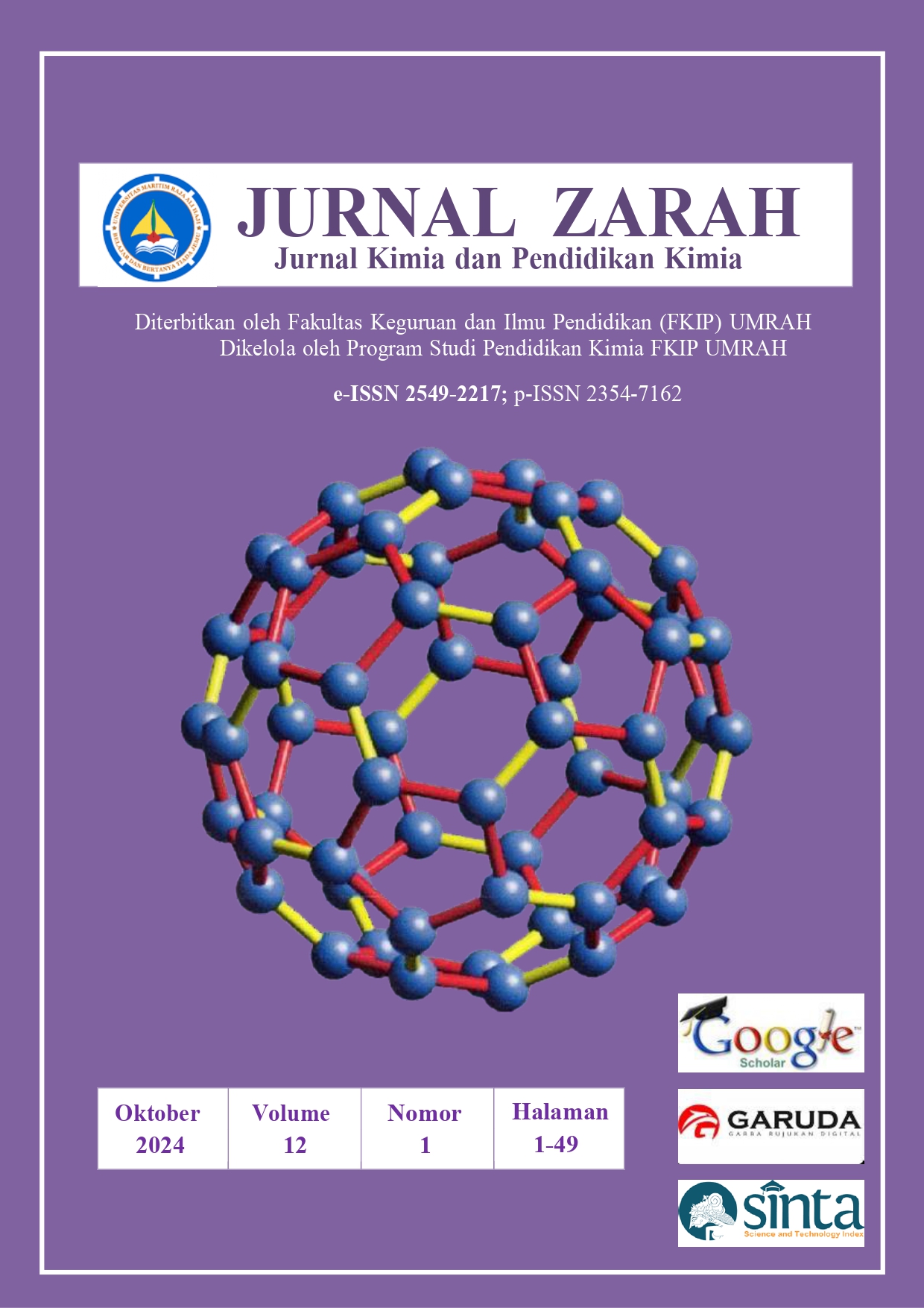KARBON AKTIF BERPORI DARI KULIT JERUK (Citrus sinensis (L.) Osbeck) MELALUI METODA DEHIDRASI UNTUK KAPASITOR ELEKTROKIMIA
Abstract
Limbah kulit jeruk (Citrus sinensis (L.) Osbeck) adalah precusor karbon aktif yang ramah lingkungan dan ekonomis untuk bahan elektroda kapasitor elektrokimia. Pada penelitian ini kulit jeruk telah dimanfaatkan sebagai precusor karbon aktif berpori melalui metoda dehidrasi dengan H2SO4 dan penambahan aktivator KOH pada suhu karbonisasi 400°C. Karbon aktif yang dihasilkan terdiri dari karbon (71,42%) dan oksigen (28,58%), dengan volume pori adalah 0,04281 cm³/g, diameter pori 2,57 nm dan luas permukaan 140 m2/g dengan struktur dominan mesopori dan sedikit mikropori. Kinerja kapasitor elektrokimia dengan menggunakan karbon aktif dari kulit jeruk mencapai 10,75 mF dengan jumlah elektron 647,365 x 1015 elektron pada kondisi luas permukaan elektroda 3x3 cm2, ketebalan elektroda 0,15 cm dan elektrolit H3PO4 0,3 N. Hasil penelitian ini menunjukkan bahwa sintesis karbon aktif kulit jeruk melalui dehidrasi asam memberikan keuntungan dalam segi efisiensi biaya, waktu dan proses preparasi untuk menghasilkan karbon aktif berpori dengan luas permukaan yang tinggi sebagai kapasitor elektrokimia berkinerja tinggi.
Downloads
References
Ahmad, T., Murtaza, Shah, S. S., Khan, S., Khan, A. A., Ullah, N., Oyama, M., & Aziz, M. A. (2023). Preparation and electrochemical performance of Convolvulus arvensis-derived activated carbon for symmetric supercapacitors. Materials Science and Engineering B: Solid-State Materials for Advanced Technology, 292. https://doi.org/10.1016/j.mseb.2023.116430
Alif, A., Tetra, O. N., Aziz, H., & Defri, H. (2017). Pengaruh Perlakuan Sokletasi dan Aktivator KOH Terhadap Kinerja Karbon Aktif Cangkang Kelapa Sawit Sebagai Elektroda Superkapasitor. Jurnal Zarah, 5(2), 38–43.
Aziz, H., Tetra, O. N., Alif, A., Syukri, & Perdana, Y. A. (2017). Performance Karbon Aktif Dari Limbah Cangkang Kelapa Sawit Sebagai ELektroda Superkapasitor. Jurnal Zarah, 5(2), 1–6.
Chae, J. H. (2014). Supercapacitors With Neutral Aqueous Electrolytes. The University of Nottingham.
Charoensook, K., Huang, C. L., Tai, H. C., Lanjapalli, V. V. K., Chiang, L. M., Hosseini, S., Lin, Y. T., & Li, Y. Y. (2021). Preparation of porous nitrogen-doped activated carbon derived from rice straw for high-performance supercapacitor application. Journal of the Taiwan Institute of Chemical Engineers, 120, 246–256. https://doi.org/10.1016/j.jtice.2021.02.021
Erprihana, A. A., & Hartanto, D. (2014). Pembuatan Karbon Aktif Dari Kulit Jeruk Keprok (Citrus reticulata) Untuk Adsorbsi Pewarna Remazol Brilliant Blue. Jurnal Bahan Alam Terbarukan, 3(2), 25–33.
Farma, R., Tania, Y., & Apriyani, I. (2023). Conversion of hazelnut seed shell biomass into porous activated carbon with KOH and CO2 activation for supercapacitors. Materials Today: Proceedings. https://doi.org/10.1016/j.matpr.2023.02.099
Jia, J., Yao, Z., Zhao, L., Xie, T., Sun, Y., Tian, L., Huo, L., & Liu, Z. (2023). Functionalization of supercapacitors electrodes oriented hydrochar from cornstalk: A new vision via biomass fraction. Biomass and Bioenergy, 175. https://doi.org/10.1016/j.biombioe.2023.106858
Khajonrit, J., Sichumsaeng, T., Kalawa, O., Chaisit, S., Chinnakorn, A., Chanlek, N., & Maensiri, S. (2022). Mangosteen peel-derived activated carbon for supercapacitors. Progress in Natural Science: Materials International, 32(5), 570–578. https://doi.org/10.1016/j.pnsc.2022.09.004
Li, J., Wei, L., Jiang, Q., Liu, C., Zhong, L., & Wang, X. (2020). Salt-template assisted synthesis of cornstalk derived hierarchical porous carbon with excellent supercapacitance. Industrial Crops and Products, 154. https://doi.org/10.1016/j.indcrop.2020.112666
Majid, S., Ali, A. S. G., Cao, W. Q., Reza, R., & Ge, Q. (2021). Biomass-derived porous carbons as supercapacitor electrodes-A review. In Xinxing Tan Cailiao/New Carbon Materials (Vol. 36, Issue 3, pp. 546–572). Institute of Metal Research Chinese Academy of Sciences. https://doi.org/10.1016/S1872-5805(21)60038-0
Marsh, Harry., & Rodríguez-Reinoso, F. (2006). Activated carbon. Elsevier.
Oyedotun, K. O., Barzegar, F., Mirghni, A. A., Khaleed, A. A., Masikhwa, T. M., & Manyala, N. (2019). Examination of High-Porosity Activated Carbon Obtained from Dehydration of White Sugar for Electrochemical Capacitor Applications. ACS Sustainable Chemistry and Engineering, 7(1), 537–546. https://doi.org/10.1021/acssuschemeng.8b04080
Syarif, N. (2014). Performance of biocarbon based electrodes for electrochemical capacitor. Energy Procedia, 52, 18–25. https://doi.org/10.1016/j.egypro.2014.07.050
Tetra, O. N., Aziz, H., Emriadi, Ibrahim, S., & Alif, A. (2018). Review: Superkapasitor Berbahan Dasar Karbon Aktif dan Larutan Ionik Sebagai Elektrolit. Jurnal Zarah, 6(1), 39–46.
Tetra, O. N., Aziz, H., Syukri, Arifin, B., & Novia, A. (2018). Pengaruh Penambahan Karbon Aktif Dari Tanah Gambut Terhadap Kapasitansi Elektroda Superkapasitor Berbahan Dasar Karbon Aktif Cangkang Kelapa Sawit . Jurnal Zarah, 6(2), 47–52.
Ukkakimapan, P., Sattayarut, V., Wanchaem, T., Yordsri, V., Phonyiem, M., Ichikawa, S., Obata, M., Fujishige, M., Takeuchi, K., Wongwiriyapan, W., & Endo, M. (2020). Preparation of activated carbon via acidic dehydration of durian husk for supercapacitor applications. Diamond and Related Materials, 107. https://doi.org/10.1016/j.diamond.2020.107906
Wang, B., Ji, L., Yu, Y., Wang, N., Wang, J., & Zhao, J. (2019). A simple and universal method for preparing N, S co-doped biomass derived carbon with superior performance in supercapacitors. Electrochimica Acta, 309, 34–43. https://doi.org/10.1016/j.electacta.2019.04.087
Zhang, Y., Sun, W., & Yang, F. (2021). Electrochemical performance of potato-derived activated carbon: Effect of compressive stress. Journal of Energy Storage, 37. https://doi.org/10.1016/j.est.2021.102476
Zhong, C., Yida, D., Hu, W., Qiao, J., Zhang, L., & Zhang, J. (2015). A Review of Electrolyte Materials and Composition For Electrochemical Supercapacitors. Chemical Society Reviews, 44, 7484–7539.
Zhu, H., Liao, Q., Hu, L., Xie, L., Qu, B., & Gao, R. (2023). Effect of removal of alkali and alkaline earth metals in cornstalk on slagging/fouling and co-combustion characteristics of cornstalk/coal blends for biomass applications. Renewable Energy, 207, 275–285. https://doi.org/10.1016/j.renene.2023.03.022
Downloads
Published
Issue
Section
License
Copyright (c) 2025 Jurnal Zarah

This work is licensed under a Creative Commons Attribution-NonCommercial-ShareAlike 4.0 International License.


